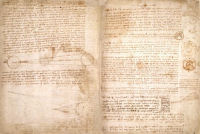The Body of Earth Click on the thumbnails to explore the trail
Read more about this trail (expand)
In his vision of the world, Leonardo saw the planet earth as a living entity, with all of its elements in a constant state of flux. As in nature form follows function, the landscape and all of its elements is seen as a product of the effects of nature that illustrates the bodily mechanisms of the earth.

- Enlarge
- Zoom & explore
- Sheet 1B Fol 36v-36r - The flow of water through the eart and water on the moon © Seth Joel/CORBIS
Codex Leicester (formerly Codex Hammer) 1508-1512
In the sketches on the right of this sheet Leonardo illustrates his global theory.
He believed the centre of the earth to be a cavern filled with water, which constantly rises to the surface through a system of subterranean veins. These subterranean waters erode the earth’s interior, causing the enormous internal caverns to collapse. As these caverns crumble, water fills them and the relative centres of gravity of the earth and the water constantly change.
The surface of the “sphere” of the liquid sea remains at a constant level, but the earth protrudes to different heights and different places, and is radically transformed over time. From this idea, Leonardo developed his hypothesis on the origin of land masses and mountains.
In Leonardo's words
The great elevations of the peaks of mountains above the sphere of the water may have resulted from the fact that a very large portion of the earth which was filled with water, that is to say, the vast cavern inside the earth, may have fallen in a vast part of its vault towards the centre of the earth, being pierced by means of the course of the springs which continually wear away the place where they pass…It is of necessity that there should be more water than land, and the visible portion of the sea does not show this; so that there must be a great deal of water inside the earth, besides that which rises into the lower air and which flows through the rivers and springs.
The Codex Leicester deals almost exclusively with science, water and hydraulics. There are also studies on the subjects of astronomy, cosmology, geology, with important notes regarding the composition and nature of the “body” of the earth.
This codex is now comprised of 18 loose double sheets, with densely compiled script in Leonardo’s characteristic mirror writing and over 300 small illustrations in the margins.
- Medium Pen and ink on paper
- Size 29 x 22 cm
- Location Private collection










